The best designed gardens will become the gardens from Hell if not properly maintained. The weeds creep in, the birds drop unwanted seeds of trees that we call volunteers, plants become larger than the catalogs say. It’s a never-ending battle.
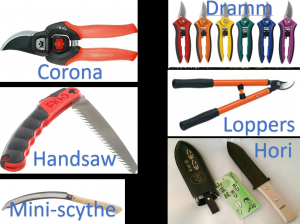
These are my tools of the trade: Corona FlexDial Carbon Steel Bypass Hand Pruners-corona.com; Dramm Colorpoint Bypass Pruner; Folding handsaw-rei.com; Loppers; Mini-scythe; Hori
The keys to good maintenance are the proper tools, timeliness, and an eye that discerns what doesn’t belong. I remember mapping a garden last year for future design and noticed that some type of bramble had established a foothold. Naturally, the homeowner never saw it, much less recognized it.
So, what tools do we need? Sharp pruners and loppers, a wrist brace, a small handsaw, a hori (instead of a trowel), a kneeling pad, and perhaps, a mini-scythe. You may be thinking that loppers and handsaws aren’t needed in a perennial garden but the new perennial garden is usually a mixed border that incorporates woody plants among the herbaceous plants.
There are many pruners on the market. The most important factor is that it fits your hand comfortably. Having small hands myself, I find that the Corona FlexDIAL Carbon Steel Bypass Hand Pruner works best for me when pruning the small branches of woody plants. For deadheading perennials or cutting them to the ground in spring, I use the Dramm Colorpoint bypass Pruner. It doesn’t open as wide as the Corona and is lighter. For larger branches of woody plants, I use loppers In those instances where loppers are not sufficient, the handsaw is my tool of choice. (Don’t forget to have your tools sharpened now.)
Repetitive motion is the main cause of carpal tunnel syndrome. There is so much pruning to do in spring that I find a wrist brace particularly effective in counteracting the repetitive motion but I have learned to use it year-round. I find that my hand does not tire as easily or ache later that evening if I use the brace.
I gave up using a trowel several years ago when I realized that it exerts pressure on the wrist and elbow. The hori (Japanese digging knife) is ergonomically designed. Stabbing it into the ground to release roots is quite beneficial while having the side benefit of releasing aggression.
Weeding needs to be done year-round but very early spring is great time to get a head start on the weeds. The more weeding you can do not the better spring is so busy with other chores. A kneeling pad isn’t essential but it does cushion the knees and keeps them dry. If you are bending over to pull weeds, you are exerting unnecessary pressure on your back and you will fail to see some of the smaller weeds or the ones mimic nearby perennials.
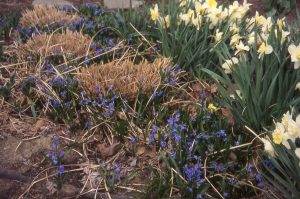
Narcissus and Scilla siberica between cut back Pennisetum
I use a mini-scythe instead of pruners to cut down ornamental grasses. For properties with extensive use of grasses, a week whip would be more time effective. The timing is crucial. March is usually the best time because the new foliage is yet to emerge. If you wait, you will be cutting the new foliage. Remind of the timing by planting early-blooming bulbs such as Narcissus and Scilla sibirica between the grasses. If you wait too long to cut down the grasses, you will miss the bulb bloom.
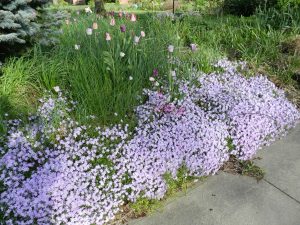
Phlox subulata definitely benefits from a haircut after bloom and keeps it from creeping out into my neighbor’s driveway.
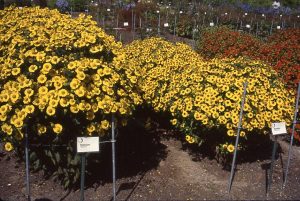
Side by side pots of Helenium at a nursery in September show the difference between what was pruned in June and what was not.
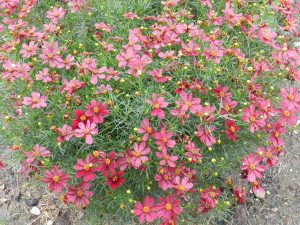
Coreopsis ‘Red Satin’ in bloom again in late July after shearing three weeks earlier.
Pruning perennials depends on their bloom time. If they bloom in Spring, e.g. Phlox subulata (Creeping Phlox), wait to prune until after bloom. Pruning then will help keep them denser. If they bloom in the fall but tend to get too tal and floppy, e.g. New England Aster or Helenium, prune them in half the first week of June. Some perennials, such as Nepeta and Coreopsis, that will rebloom in flushes throughout spring and summer, can be sheared back by a third after each flush.
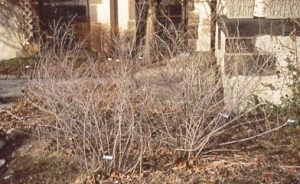
In early Spring, the silvery stems of Perovskia beg us to prune them but it is prudent to wait until at least late April.
For subshrubs (perennials with a woody structure), e.g., Perovskia, pruning too early is disastrous. Even though you may see new foliage in April, wait at least two more weeks and, even then, don’t prune further down than one foot; otherwise, a hard frost could kill the whole plant. Once the frost-free date is past, you can prune further down if you want to keep the plant from getting too large.
Pruning shrubs appropriately depends on when they bloom. Spring bloomers as Deutzia ‘Chardonnay Pearls’ should not be pruned until after bloom. Summer bloomers, e.g. Clethra and Hydrangea paniculata, should be pruned in the Spring.
So, now that temperatures are moderating, we can finally start working in the garden. Be sure to loosen the piles of leaves (but don’t rake them out of the garden; leave them to decay) that may be covering the emerging foliage of spring-blooming bulbs and cut flower stalks to the ground. If they’re brittle, you can break them up and sprinkle them on the ground where they will also decay.


0 Comments